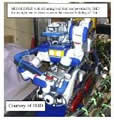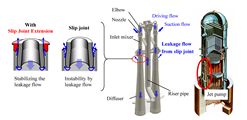Classification
7 - C Dismantling/Decontamination
Reduction of the dose equivalent rates inside the reactor buildings of Fukushima daiichi nuclear
power station is quite important issue for decommissioning. Dose equivalent rate inside the reactor
buildings is quite high. For example, dose equivalent rate of 1st floor on the Unit 1 is 1.2 - 1820
[mSv / h], the Unit2 is 2.5 - 220 [mSv / h] and Unit 3 is 2.2 - 4780 [mSv / h]. So workers cannot
work for long hours.
Therefore teleoperated robot which makes possible for workers to work for long hours is
indispensable. Furthermore teleoperated robot is required to be versatile robot because performing
various kinds of works at Fukushima daiichi nuclear power station will be required in the future.
MHI-Teleoperated Robot which reflects above demand and possibility has been developed as shown
in Fig.1.
Additionally concrete core sampling from the buildings to investigate the contamination is
necessary for studying about effective decommissioning.

Fig.1: MHI-Teleoperated Robot
- (1) Components:
Reactor building
- (2) Location: Disaster site
- (3) Materials: Concrete
- (4) Condition: N/A
4. Features
- (1)MHI-MEISTeR
- MHI-MEISTeR was developed based on the RaBOT (Radiation – proof roBOT) delivered by MHI
to the Japan Atomic Energy Agency (Japan Atomic Energy Research Institute at that time) as one of
several nuclear hazard response robots developed in the wake of the criticality accident at the nuclear
fuel processing facility in Tokai-mura, Ibaraki, in 1999. Based on MHI’s abundant maintenance
technologies cultivated at nuclear power facilities, many improvements were incorporated into
MHI-MEISTeR to be able to use at Fukushima Daiichi Nuclear Power Station. This improvement
activity was implemented in cooperation with Tokyo Electric Power Company (TEPCO), and the
International Research Institute for Nuclear Decommissioning (IRID),and a part of a project funded
by the Japanese Ministry of Economy, Trade and Industry (METI).
The MHI-MEISTeR is equipped with enhanced radiation protection, including anti-contamination measures, as well as improved remote control capability. The arms of MEISTeR can move freely similar to human arms due to its 7-axis control system. Each arm can carry objects weighing up to 15kg. General specification of MHI-MEISTeR is shown in Table.1.
However, any transparent platy resinous covers such as acrylic did not have the transmittivity for the infrared rays. (Fig.1)
Table.1 General specification of the MHI-MEISTeR

- (2)Tools mounted to the arm ends
- Concrete core sampling tool, vacuum decontamination tool, blasting decontamination and gathering
tool are mounted to the arm ends in accordance with the request from the work items as shown in the
Fig.2 and 3.

Fig.2MHI-MEISTeR with vacuum decontamination tool

Fig.3 MHI-MEISTeR with gathering tool
5. Examples of Application
- (1)Concrete core sampling and decontamination processes in Unit 1
- MHI-Teleoperated Robot took concrete core samples from the 1st floor in Unit 1 and performed
demonstrational operation of vacuum decontamination and blasting decontamination.
MHI-Teleoperated Robot moved in the 1st floor, and took 3 concrete core samples at “a”, “b” and “c”
as shown in Fig.4. A photograph of a concrete core sample is shown in Fig.5. The samples were
delivered to a laboratory and investigated by Japan Atomic Energy Agency (JAEA) for studying
effective decontamination methods.
MHI-Teleoperated Robot conducted the vacuum decontamination at ”d” and “e” as shown in Fig.6 after the concrete core sampling. Total decontamination area was approximately 3 [m2]. Surface concentration of contamination was reduced from 5.3E4 [<Bq/cm2(*1)] to “Lower than detectable” (LTD) (8.1E3[Bq/cm2]). The decontamination Factor (DF) was more than 6.5. The photographs of the vacuum decontamination area are shown in Fig.7. And then, MHI-Teleoperated Robot conducted the blast decontamination at “d” as shown in the Fig.6. Total decontamination area was 1 [m2]. The DF wasn’t calculated because the contamination level before performing blast decontamination was already LTD. The photographs of the blast decontamination area are shown in Fig.8. MHI operated during 1 day for vacuum decontamination and 1 day for blast decontamination and 9 days for Fig.3: MHI-MEISTeR with gathering tool Fig.2: MHI-MEISTeR with vacuum decontamination tool 4 preparation and clean-up nearby reactor buildings.
(*1) Bq/cm2: Amount of radioactivity per cm2
Fig.4 Traffic route for concrete core sampling in Unit1

Fig.5 A concrete core sample from Unit 1

Fig.6 Decontamination area in Unit1

Fig.7 Vacuum decontamination at “d”

Fig.8 Blast decontamination at “e”
- (2)Decontamination process in Unit 3
- MHI-Teleoperated Robot operated the vacuum decontamination and gathering the rubble on the 1st
floor of Unit 3. Main purpose for the MHI-Teleoperated Robot in this mission was removing the dust
and the rubble. These are typical radioactive sources in the reactor building. First, MHI-Teleoperated
Robot came into the 1st floor through a gateway as shown in Fig.9. And MHI-Teleoperated Robot
conducted the vacuum decontamination to the flooring at “j” and “k” as shown in Fig.9. Total
decontamination area was approximately 25.9 [m2]. Effectiveness of vacuum decontamination was
proved by the result of activity in Unit 1. However dose equivalent rates before/after vacuum
decontamination is measured as a reference. Dose equivalent rates were reduced from 11- 20 [mSv/
h(*2) ]to 8- 13[mSv/ h] at “j” and from 11- 33 [mSv/ h] to 10- 28[mSv/ h] at “k”. Next, teleoperated
robot gathers the rubble at area “l” as shown in the Fig.9. Photographs of gathering process are
shown in Fig.10 to Fig.11. Total content of the gathered rubble was approximately 73.8 litters.
Photographs of area before and after gathering are shown in Fig.12. MHI operated during 13 days for
vacuum decontamination, 9 days for gathering the rubble and 12 days for preparation and clean-up
nearby reactor buildings. (*2) mSv/ h: Radiation exposure per hour
(*2) mSv/ h: Radiation exposure per hour

Fig.9 Traffic route in Unit 3

Fig.10 Gathering the rubble tools

Fig.11: Transportation of the rubble in the bucket

Fig.12: Area of gathering the rubble
6. Conclusion
- (1)Summary of application
- MHI-Teleoperated Robot had been successfully applied to the Fukushima daiichi for
decommissioning processes. MHI-Teleoperated Robot operated the vacuum / blast decontamination,
concrete core sampling, and the gathering the rubble in the reactor buildings.
- (2)Future
- Decontamination work should be operated as soon as possible and in safe. Each process operated by
Teleoperated robot will be improved in some points: Power up of the arms, enhancement of
automatically movement, operation in 2 or 3 shifts, and so on. However each item has merit and
demerit, for example, change the arm manipulator is simple improvement but costs quite high.
Effective improvements will be applied after the cost-effectiveness analysis for each item.
Various remote operating system and robots will be designed and applied for the work of the decommissioning of the Fukushima daiichi. However, some serious troubles might occur in the robots, and some of the robots might be broken in a high radioactive area. So, it is very beneficial to develop of the MHI-MEISTeR's new tools that are available for maintenance for the other robots. For example: wire connection / disconnection, screw driver works, voltage measurement, soldering, welding, and so on.
Based on this experience, MHI intends to improve the robotics technologies continuously. Also, MHI keeps making contribution to the decommissioning at Fukushima daiichi, including applications of more advanced robots.
7. Reference
- 1Mitsubishi Heavy Industries, “MHI Develops "MEISTeR" Disaster Recovery Support Robot With 2 Arms Enabling Light-duty Work Tasks-- Broad Versatility for Carrying, Drilling and Valve Opening/Closing Through Attachment Tool Changes --”, Press Information, posted on Dec. 12, 2012, http://www.mhi-global.com/news/story/12121603.html, accessed on Dec. 12, 2012.
- 2Mitsubishi Heavy Industries, “MEISTeR” Remote Control Robot Completes Demonstration Testing At Fukushima Daiichi Nuclear Power Station --Performs Decontamination Work and Concrete Core Sampling --”, Press Information, posted on Feb. 20, 2014, http://www.mhi-global.com/news/story/12121603.html, accessed on Feb. 20. 2014.
- 3Noriaki SHIMONABE et al., “Development of Remote Decontamination Techniques for Reactor Building (7) Base Data Acquisitions – Concrete Core Sampling”, 2014 fall Meeting of the Atomic Energy Society of Japan, p124, Sep. 2014.
- 4Atsushi HIGASHIUCHI et al., “Development of Remote Decontamination Techniques for Reactor Building (8) Analysis of Concrete core sample from Operation Floor if Unit 2”, 2014 fall Meeting of the Atomic Energy Society of Japan, p125, Sep. 2014.
- 5Hironori ONITSUKA et al., “Development of Remote Decontamination Techniques for Reactor Building (4) Demonstration test of Suction and Blasting Decontamination”, 2014 fall Meeting of the Atomic Energy Society of Japan, p125, Sep. 2014.
- 6Kobedigital, “MHI Develops "MEISTeR" Disaster Recovery Support Robot With 2 Arms Enabling Light-duty Work Tasks-- Broad Versatility for Carrying, Drilling and Valve Opening/Closing Through Attachment Tool Changes --”, posted on Dec. 6, 2012 https://www.youtube.com/watch?v=bdQRN2bPVnQ
- 7Tokyo Electric Power Company, “"MEISTeR" Disaster Recovery Support Robot With 2 Arms for decontamination works --”, posted on Feb. 7, 2014 http://photo.tepco.co.jp/date/2014/201402-j/140207_01j.html
Japan Society of Maintenology (ejam@jsm.or.jp)




